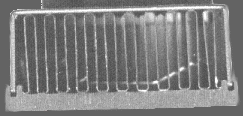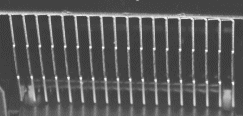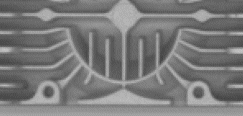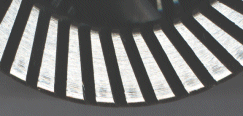Heatsink Guide - The Basics of Cooling & Heatsink Technology
by Tillmann Steinbrecher on January 5, 2000 12:02 AM EST- Posted in
- Guides
The production method
Different heatsink manufacturers
have come up with many different production methods. Let's have a look at
some of the popular heatsink designs:
|
Extruded
heatsink
 |
"Folded
fin" heatsink |
|
"Bonded
fin" heatsink |
Die-cast
heatsink |
|
Cold
forged heatsink |
Milled
/ cut heatsink |
- Extrusion is
the most popular production method for heatsinks. It is inexpensive, and
quite fine structures can be created using this production method. The liquid
aluminum is pressed through a form, so that a long stick with the shape
of the heatsink is created. After this "heatsink stick" stick has cooled
down, it is cut into pieces the size of the heatsink. However, there are
certain limitations with this production method. For example, a heatsink
shape like the one shown in the fourth image could not be produced with
this method.
- Folded fin design:
Here, the fins are made of a thin metal plate, which is folded, and bonded
onto a base plate. The advantage is that the fins are hollow, so they have
a bigger surface and allow better airflow (and thus better cooling). Using
this design, light, compact, and still very efficient coolers can be designed.
The disadvantage is that heatsinks with folded fins are more expensive to
produce, and therefore only a few manufacturers offer coolers using this
design.
- Bonded fin design:
This design is very similar to the "folded fin design", except that here,
many smaller metal plates are bonded onto the base plate, instead of one
large folded plate.
- Die casting:
This production method gives the heatsink designer a lot of freedom, and
allows for certain heatsink shapes that cannot be produced using extrusion.
However, the fins of a die cast heatsink cannot be very fine.
- Cold forging:
This is a relatively exotic production method. It's included here because
a very popular heatsink, the Alpha PFH6035MUC, is produced using this method.
This technology is very suitable for heatsinks with many small pin fins.
- Milling: Like cold forging, this production method is quite unusual for heatsinks. It's included in the chart because the heatsinks by HP PolarLogic are produced this way. Milling leaves the heatsink designers a lot of freedom, too, but it is expensive.
Of course, this is not an exhaustive list, but almost all CPU heatsinks available on the market today are produced with one of the above production methods.















0 Comments
View All Comments